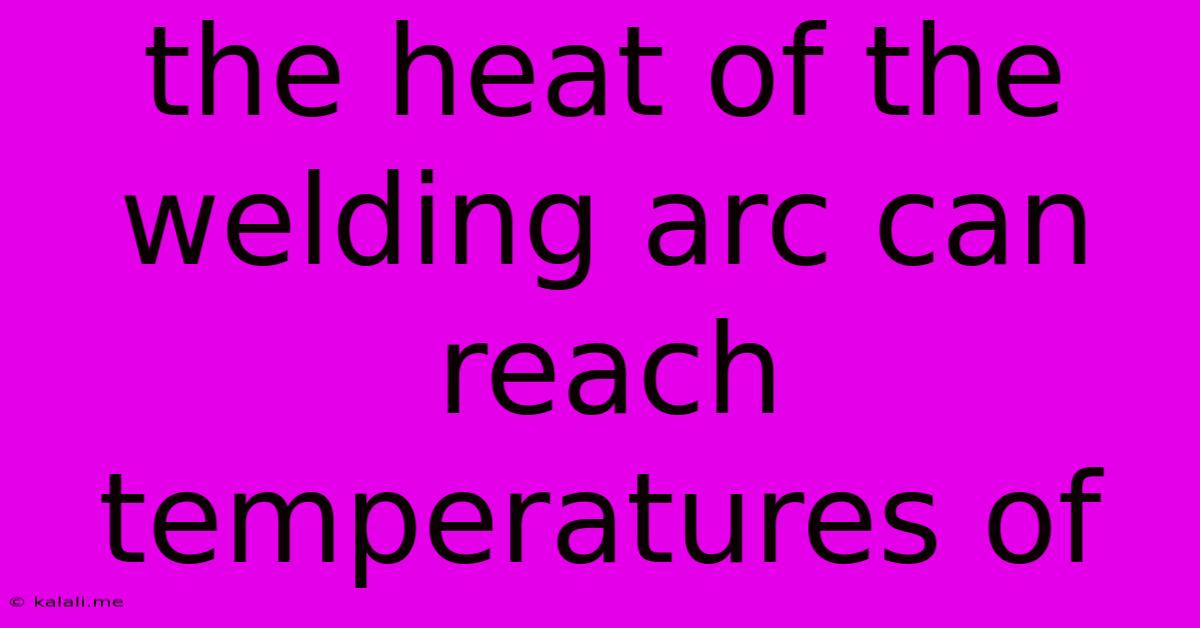The Heat Of The Welding Arc Can Reach Temperatures Of
Kalali
Jun 14, 2025 · 3 min read

Table of Contents
The Heat of the Welding Arc: Reaching Extreme Temperatures
The welding arc, that dazzling bridge of energy between electrode and workpiece, generates truly phenomenal heat. But just how hot does it get? Understanding the intense temperatures involved is crucial for welder safety, material selection, and achieving high-quality welds. This article delves into the extreme temperatures reached by a welding arc, the factors influencing this heat, and its implications.
The heat of a welding arc isn't a fixed number; it varies significantly depending on several key factors. Instead of a single temperature, we're dealing with a range, often reaching temperatures exceeding 6,000°C (10,832°F), hot enough to vaporize most metals. This intense heat is what allows for the melting and fusion of materials, forming the strong joints that welding is known for.
Factors Affecting Welding Arc Temperature
Several factors contribute to the variability of welding arc temperatures:
-
Welding Process: Different welding processes generate different heat levels. Gas Metal Arc Welding (GMAW), for instance, typically produces lower temperatures compared to Gas Tungsten Arc Welding (GTAW), which often reaches higher temperatures due to its concentrated arc. Shielded Metal Arc Welding (SMAW) falls somewhere in between. The arc characteristics also differ, with pulsed GMAW showing lower average temperatures than constant current GMAW.
-
Welding Current: Higher welding currents directly translate to higher temperatures. The increased current flow delivers more energy to the arc, resulting in a more intense heat source. This is a crucial parameter the welder controls to tailor the weld to the specific material and application.
-
Welding Voltage: Similar to current, higher voltages generally increase the arc's temperature. The voltage influences the arc length and its overall electrical characteristics. Maintaining optimal voltage is critical for consistent welding.
-
Electrode Type and Size: The type of electrode material and its diameter significantly impact the heat generated. Different electrode materials have different melting points and electrical conductivities. Thicker electrodes generally handle higher currents, leading to higher temperatures.
-
Travel Speed: The speed at which the electrode moves along the workpiece affects heat input. Slower travel speeds allow for more heat to be concentrated in a smaller area, leading to higher temperatures and deeper penetration. Conversely, faster speeds distribute heat over a larger area, resulting in shallower penetration and lower temperatures.
-
Shielding Gas: The type of shielding gas utilized also plays a role. Different gases have different thermal conductivities, influencing how the heat is transferred and distributed within the arc. This is particularly important in processes like GMAW and GTAW.
Implications of Extreme Arc Temperatures
The intense heat generated by the welding arc has several critical implications:
-
Material Selection: Welders must carefully select materials capable of withstanding these extreme temperatures without degrading or melting prematurely. The base materials being joined must be compatible, and filler materials (if used) must have appropriate melting points and properties.
-
Safety Precautions: The high temperatures present a significant safety hazard. Welders must always employ appropriate safety gear, including welding helmets with appropriate shade numbers, gloves, and protective clothing. Understanding the heat distribution in the process is crucial for avoiding burns and other injuries.
-
Weld Quality: Proper control of the arc's temperature is essential for achieving high-quality welds. Too much heat can lead to excessive penetration, burn-through, and distortion. Too little heat can result in insufficient fusion, porosity, and weakened joints.
-
Heat Affected Zone (HAZ): The area surrounding the weld, known as the HAZ, experiences significant temperature changes during the welding process. Understanding the HAZ's characteristics is crucial for predicting the mechanical properties of the final weldment.
Understanding the extreme temperatures generated by the welding arc and the factors that influence them is paramount for welders of all skill levels. Mastering control over these variables is key to producing safe, efficient, and high-quality welds.
Latest Posts
Latest Posts
-
What Are The Prime Factors Of 62
Jun 15, 2025
-
Does University Of Tampa Require Sat
Jun 15, 2025
-
What Important Topic Is Discussed In This Passage
Jun 15, 2025
-
Example Of Foreclosure Letter From Bank
Jun 15, 2025
-
What Is The Factors Of 44
Jun 15, 2025
Related Post
Thank you for visiting our website which covers about The Heat Of The Welding Arc Can Reach Temperatures Of . We hope the information provided has been useful to you. Feel free to contact us if you have any questions or need further assistance. See you next time and don't miss to bookmark.